Unable to sleep, Lucy tosses and turns in bed at night. A silhouette passes the transparent wall of her tent. It’s Aslan. Lucy wakes up Susan and, taking their Christmas presents with them, the two follow Aslan as he slips out of camp. In the book, Susan didn’t need to be awakened as she was also awake, worrying about Aslan’s strange moodiness. I kind of wish that could have been the case in the movie too. Just because Lucy is the less flawed of the two it doesn’t mean Susan can’t ever be sensitive.
I wrote in a previous post about the movie seeming to avert the idea of Aslan being omniscient but, in this scene, he arguably comes across as more omniscient than in the book. There he only noticed the girls following him when he turned around while they were in an exposed place with nowhere to hide. Here, without turning around, he says to them while they’re hiding behind a tree, “Shouldn’t you both be in bed?” That could just be implying that they’re really bad at stealth though. After an embarrassed moment, they approach him. “We couldn’t sleep,” explains Lucy. “Please, Aslan, couldn’t we come with you?” Susan asks humbly. “I would be glad of the company for a while,” says Aslan, “thank you.” They put their hands in his mane and continue through the woods. This scene is more dramatic in the book with Aslan moaning and stumbling and the girls tearfully begging him to tell them what’s wrong. Honestly, I’m OK with the way they do it here though. Partly because I don’t think the movie has succeeded quite enough in making Aslan scary for his vulnerability to have the same effect as in the source material. While Lucy is a bit cautious about touching him, it doesn’t come across as the terrifying liberty that the book implies. And partly because, given the direction this scene is headed, a lot of moaning and weeping might have felt like overkill.[1]No pun intended. That’ll make sense in a little bit.
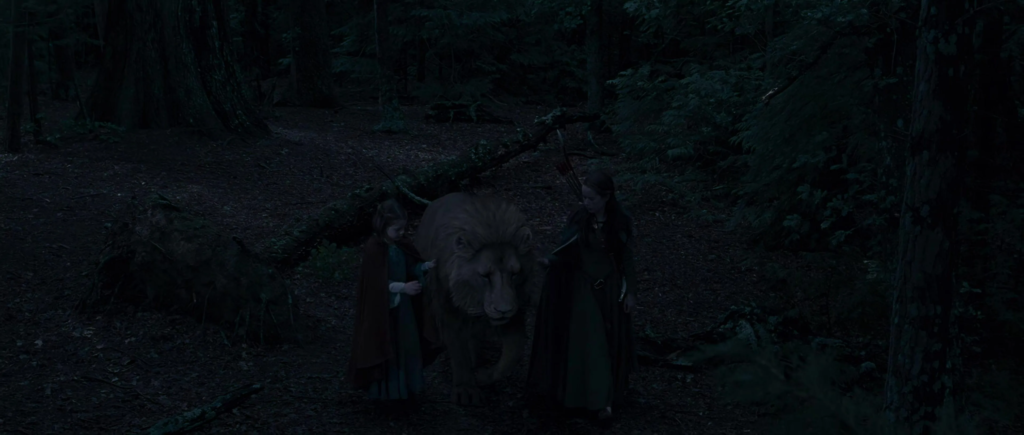
Aslan: It is time. From here, I must go on alone.
Susan: But, Aslan-
Aslan: You have to trust me for this must be done. Thank you, Susan. Thank you, Lucy. And farewell.
Aslan walks off. The girls watch him go. But instead of returning to the camp, they sneak around and, crouching in the undergrowth, see that Aslan is going to the Stone Table, around which a crowd with torches waits.
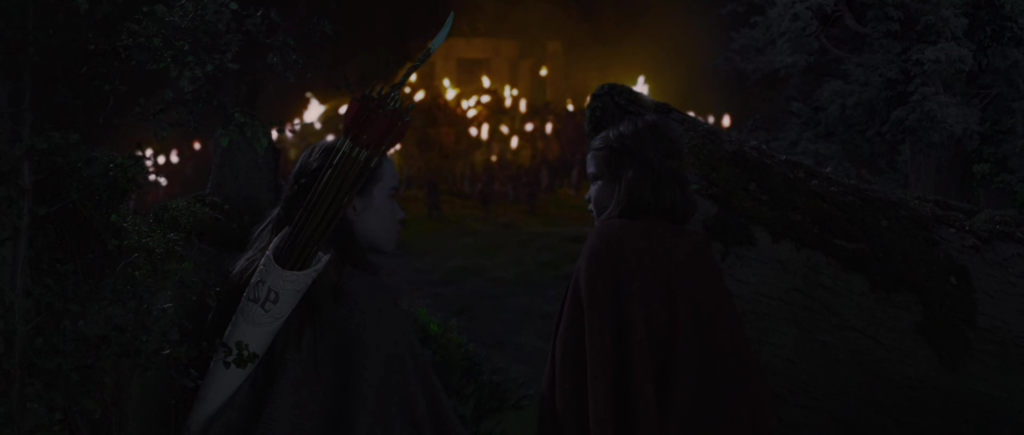
Head bowed, Aslan makes his way through the Witch’s followers.[2]I’m not going to list all the species. If you’re interested, read the book or maybe look up some old promotional material for the movie. C. S. Lewis quipped that if he described some of these monstrous creatures, “the grownups would probably not let (kids) read this book.” The movie does a great job of making these monsters look hideously grotesque while still keeping within a PG rating. The White Witch’s soldiers also have a variety and a whimsy to their designs, making them visually fun where, say, the orcs from the Lord of the Rings movies were simply repellent.[3]I don’t necessarily mean that as a knock on those movies. After all, they were trying to tell a very different story from The Lion, the Witch and the Wardrobe with a different atmosphere and to … Continue reading The movie also does a pretty good job in this scene of showing that they’re afraid of Aslan.
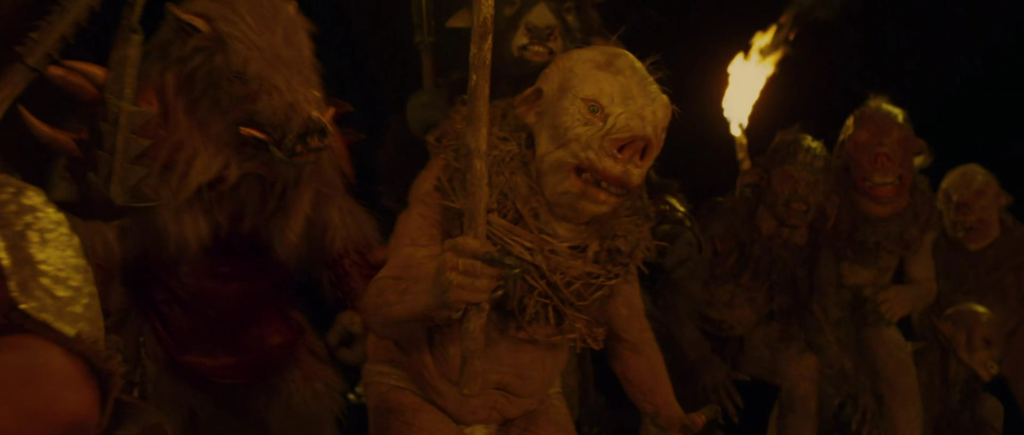
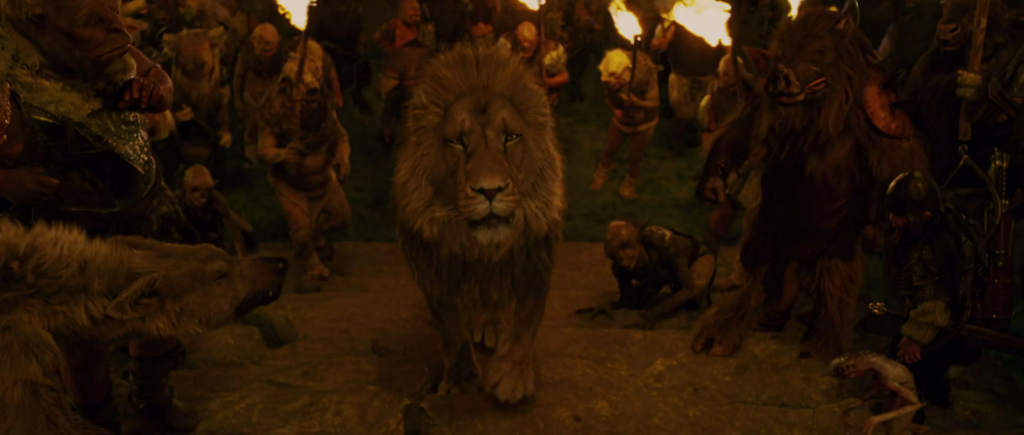
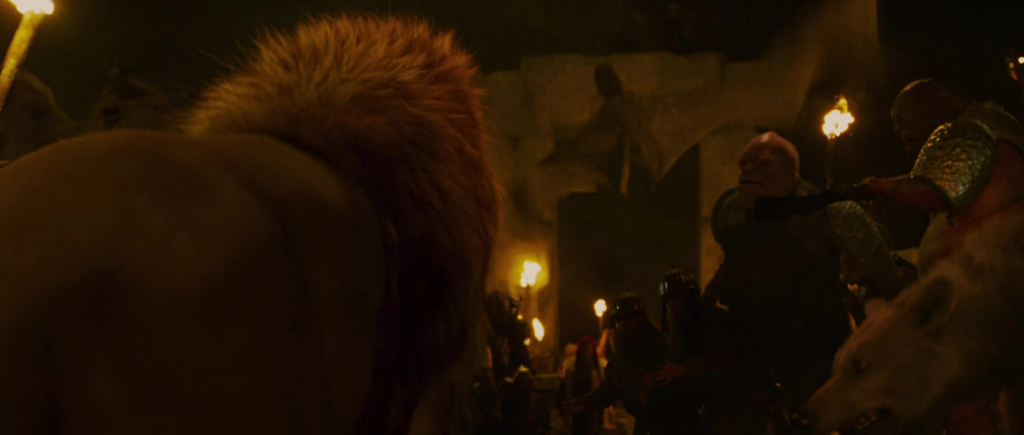
The White Witch stands atop the Stone Table, waiting for Aslan, dressed in black and carrying a ceremonial knife. “Behold the Great Lion,” she says. Her followers laugh on cue. From their hiding place, Susan and Lucy look confused. The minotaur general cautiously prods Aslan with his battleax. Aslan doesn’t resist but a little snarl escapes him. The general looks back at the Witch, not quite confident in proceeding. But then, to the girls’ shock, he violent knocks Aslan to the ground. The Witch’s other followers draw near and jeer at him. “Here, kitty, kitty,” taunts Ginarrbrik, “do you want some milk?” I’m surprised the movie doesn’t have Lucy try to rush to Aslan’s assistance here and Susan hold her back. It would have made a lot of sense. “Why doesn’t he fight back?” Lucy asks. Susan has no answer. “Bind him,” commands the Witch. Her soldiers, now that they’re not as scared, rush forward and tie cords around Aslan’s paws, body and mouth. (According to the book, they tie them so tightly that they cut into his flesh!) “Wait,” the Witch suddenly says, “let him first be shaved.” The creatures cheer at this. Ginarrbrik comes forward, saws off a tuft of Aslan’s mane and holds it up like a trophy to much cheering. Others eagerly gather around and hack off the mane, tossing hair into the air like confetti. “Bring him to me,” says the Witch. The creatures roughly drag Aslan up onto the table-the way his jaw bangs against the stones can make you wince-and tie him there. Their bloodlust is at a fever pitch when the Witch holds up her hand and the scene goes silent.
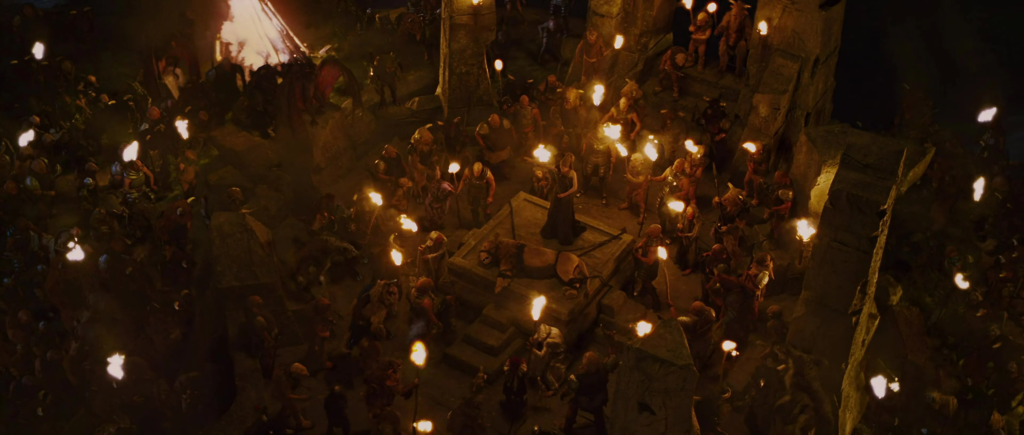
Then four hags carrying torches start-wait, I’ve got to talk about the design for these characters. I’ve always assumed that by “Hags” the Narnia books meant stereotypically old and ugly Halloween-type witches as opposed to the beautiful enchantress archetype represented by the White Witch. But for whatever reason, the movie gives them these weird beaks. My guess is that they felt unattractive older women would look mundane in the company of all these horrible monsters. It’s a bit of an odd decision but it doesn’t distract me in context.
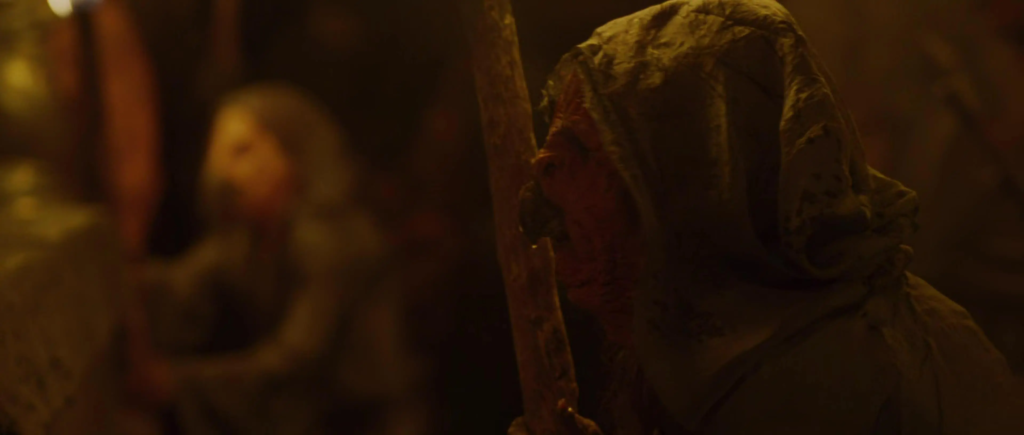
The hags start pounding out a rhythm with their torches. Other creatures take it up. Some of them hiss or bellow. The wolves howl. It’s awesomely eerie. I love the music here. It would be easy to simply make the scene scary, but I applaud the soundtrack for focusing on the sadness of it just as this scene in the book does. For me, the whole sequence is one of the most epic in the movie. It’s one of the parts that makes me believe I’m watching The Lion, the Witch and the Wardrobe, not just a version of The Lion, the Witch and the Wardrobe. The White Witch kneels down and addresses her victim. “Now, Aslan,” she says, “I’m a little disappointed in you.” In the book, she begins this speech with the words, “And now who has won?” That strikes me as more dramatic but, oh well, I guess this isn’t bad. “Did you honestly think by all this that you could save the human traitor?” she asks. Lucy and Susan look at each other, aghast, as they realize the reason for Aslan’s lack of resistance. Don’t tell me they shouldn’t be able to hear from so far away and with the crowd making so much noise! It’s a great dramatic moment.
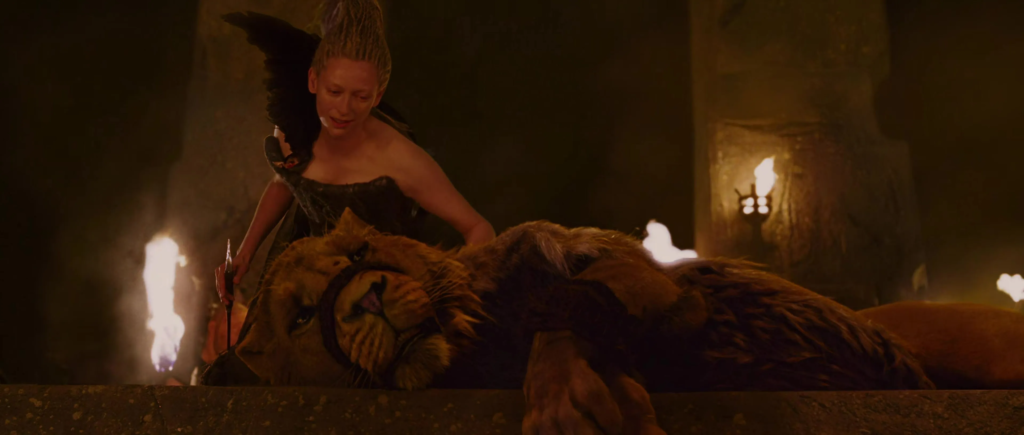
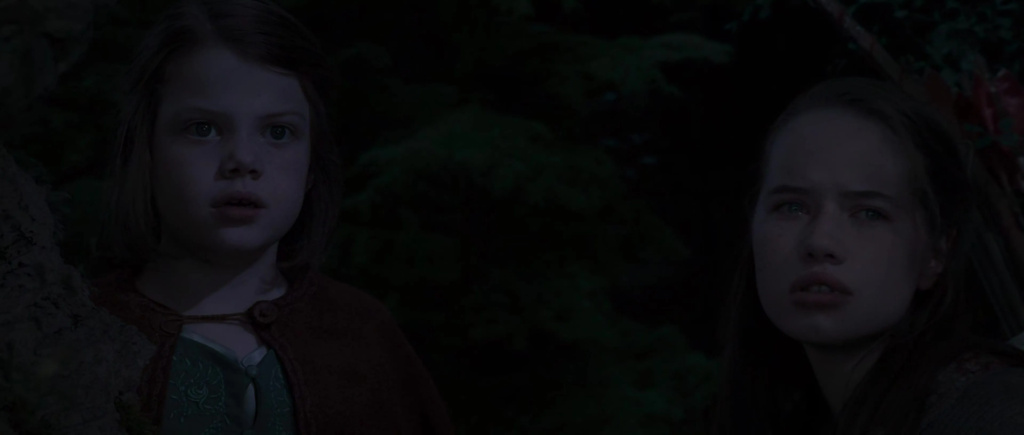
“You are giving me your life,” continues the Witch, “and saving…no one. So much for love.” That last line is really corny on paper, but Tilda Swinton’s delivery actually makes it chilling. The Witch rises and addresses her followers. “Tonight,” she proclaims, “the Deep Magic will be appeased. But tomorrow we will take Narnia forever!” In the book, that part of her speech came before her telling Aslan that his sacrifice will be in vain, and I think it flowed better that way, the idea being that once Aslan is dead, he won’t be able to stop her from killing Edmund and everybody else who is a threat to her. I wouldn’t say the movie’s rearranging ruins the speech though. You can still follow her logic; it just takes a little more thought. Anyway, her followers cheer and their rhythmic pounding speeds up, becoming more and more frenzied. The Witch raises her knife above Aslan. “In that knowledge,” she says, “despair…” Lucy seems to make eye contact with Aslan[4]Don’t tell me there’s no way she could do so! This is a great scene., silently begging him to do something.
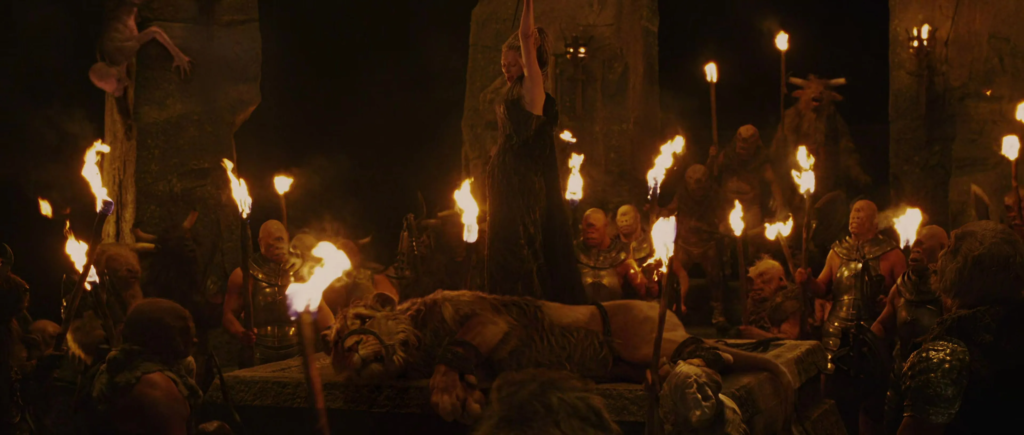
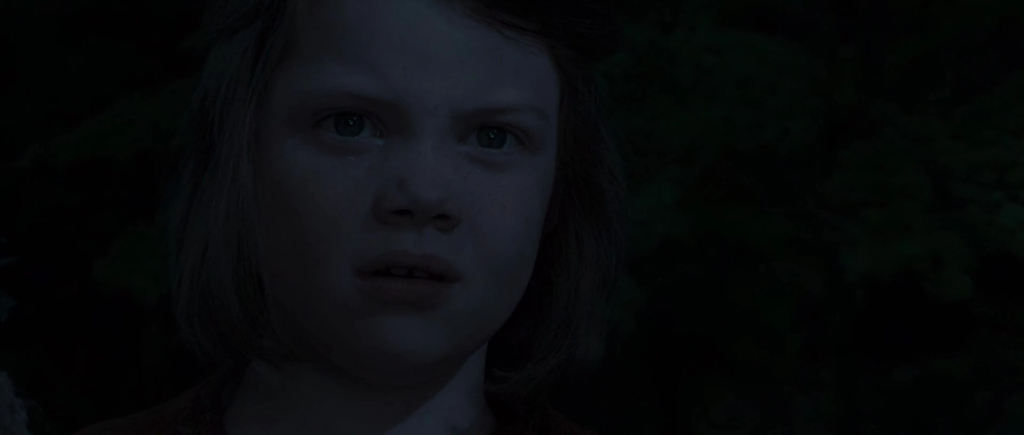
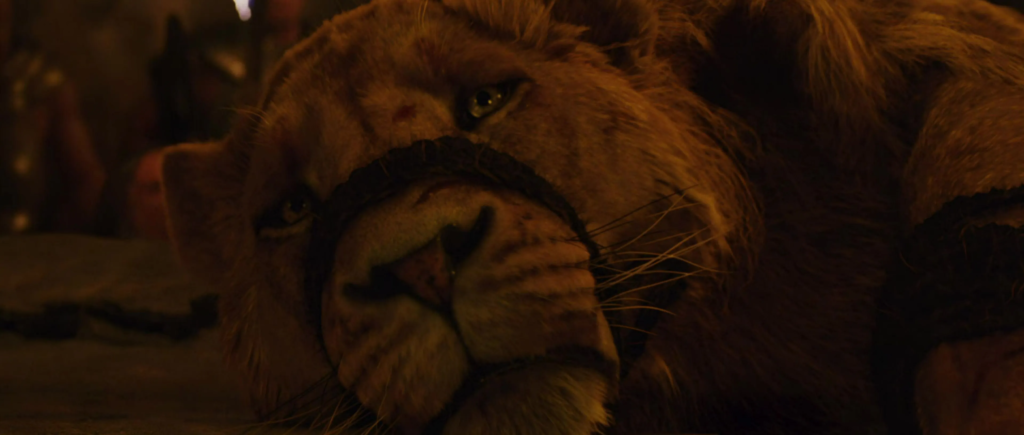
“…And die!” concludes the Witch, bringing down her knife. The movie arguably makes the scene a tad darker than the book, according to which “The children did not see the actual moment of the killing. They couldn’t bear to look and had covered their eyes.” Here the camera cuts between Lucy’s wide-open eyes and Aslan’s face as the life goes out of him. The girls hug each other and weep. “The great cat is dead!” shrieks the Witch. Her army cheers. “General, prepare your troops for battle,” she says, “however short it may be.”
We cut to the Stone Table after the Witch and her followers have left. In the dim light of very early morning, Susan and Lucy approach Aslan’s lifeless body. In a poignant detail original to this version, Lucy has a moment of hope and takes out her bottle of healing cordial. “It’s too late,” says Susan gently. “He’s gone.” She manages to smile through her tears as she tells Lucy, “He must have known what he was doing.” Some fans of the book might reasonably object that for Susan to be calm and collected enough (initially anyway) to tell Lucy this lessens the scene’s power. In the book, basically all either girl could do at this point was cry, hold hands and be silent. Lewis writes of them being up all night and crying until they have no tears left in them. I can understand someone not liking this little moment in the movie. But I’ve got to say I love it. Up until this point, Susan has been the most skeptical character in the movie, expressing incredulity at the ideas of a magical world inside a wardrobe, robins and beavers talking, ordinary children becoming heroes and Father Christmas.[5]Remember that this adaptation’s version of Father Christmas specifically told her to trust in her bow. That wording might have significance. For her to be the one to maintain that Aslan knew what he was doing when it appears to common sense that he made a terrible mistake and played right into the Witch’s hands, rather than the more intuitive Lucy, is a powerful character moment. We’ve also seen her try to be a mother to Lucy without much success throughout the story and it’s nice to see her be as comforting a presence as possible in this devastating situation.[6]The book also arguably had Susan show some impressive growth a little before this scene. Previously, she’d been the most fearful of the Pevensies, but she asked to accompany Aslan wherever he … Continue reading In any case, she and Lucy do break down sobbing and bury their faces in Aslan’s body afterwards though this doesn’t go on for as long as the book implies. The music also isn’t as emotionally intense as I’d have imagined, but it’s still beautiful in its subtler way.
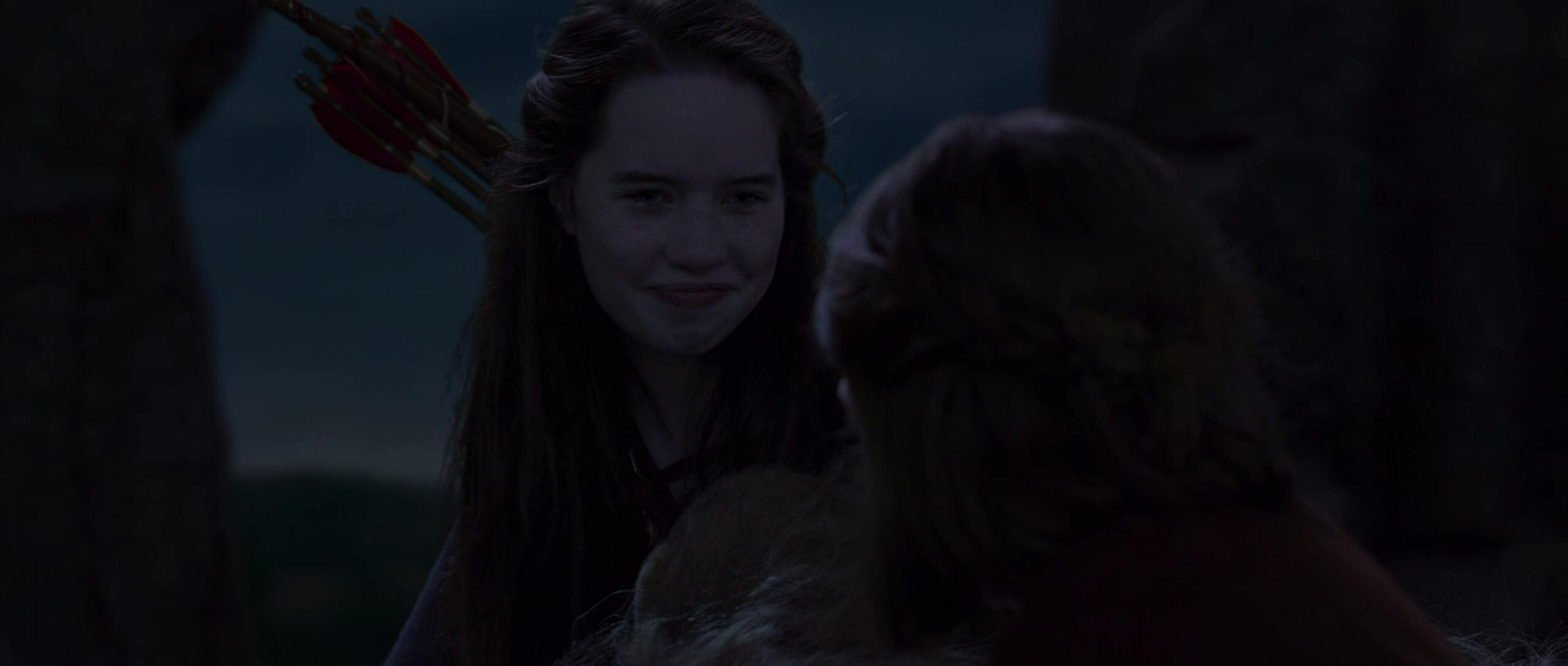
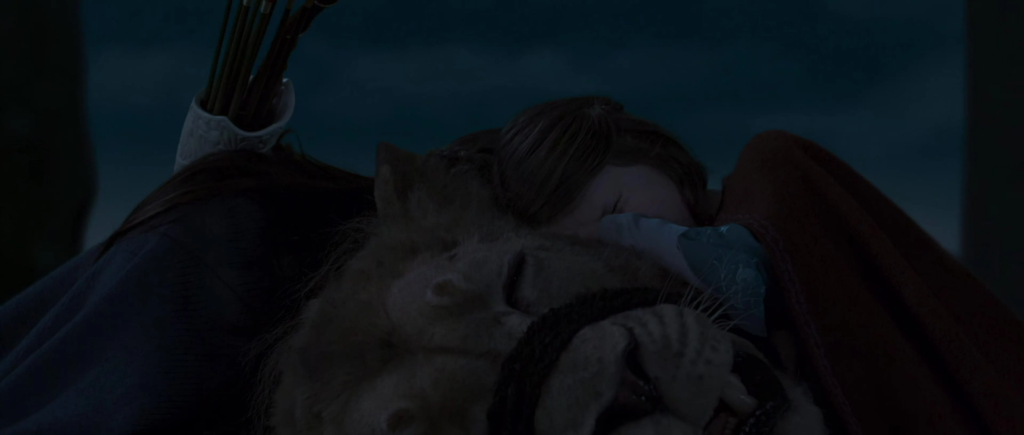
A squeaking noise causes the girls to look up from their crying. They see mice are crawling all over Aslan’s body. Disgusted, Susan tries to shoo them away, but Lucy stops her, realizing that the mice are actually chewing away the cords. The girls help remove the last of them. Lucy strokes Aslan’s unmuzzled face before burying her own in it.
Susan: We have to tell the others.
Lucy: We can’t just leave him!
Susan: Lucy, there’s no time! They need to know.
Lucy can’t argue with this, but she still doesn’t want to move. Then she has an idea. “The trees,” she says. We cut to a strange wind blowing through the forest, scattering leaves and cherry blossom petals. It enters Peter and Edmund’s tent, waking them. The petals coalesce into the form of a dryad (Katrina Browne.)[7]Browne is actually credited as a Green Dryad, not a cherry blossom one but since this is the only dryad with a speaking role in the movie, I assume it’s she. “Be still, my princes,” she says, “I bring grave news from your sisters.” Lucy and Susan send no such message in the book, being probably too distraught to think of doing so. I approve of this alteration. Since a lack of dryads in Narnia is important in the next entry in the series, Prince Caspian, it makes sense to emphasize their presence in this one.
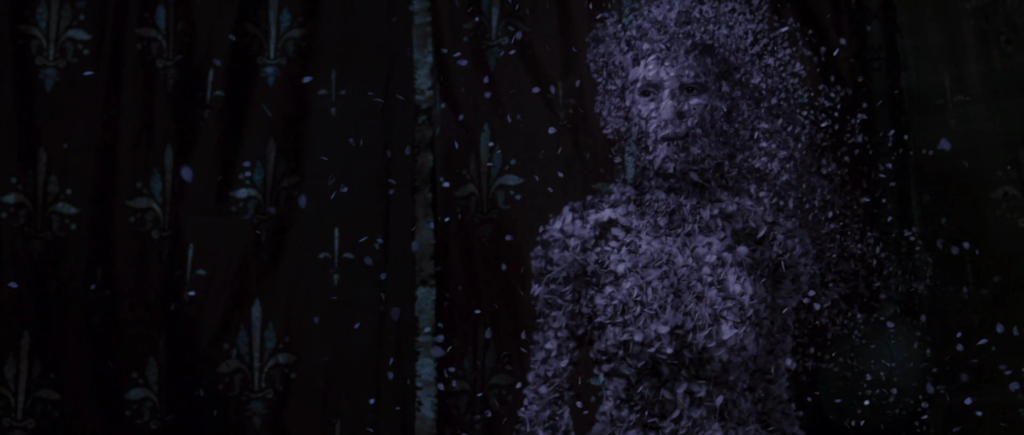
As the rest of the camp awakens, Peter sadly comes out of Aslan’s tent. “She’s right,” he says, “He’s gone.” He stares down at a battlefield map. Edmund is weirdly unphased by this, considering that he’s the one responsible for Aslan’s sacrifice. In the book, Susan even tells Lucy not to tell him about it lest the guilt be too devastating. Later books imply he was eventually informed as others mention Aslan’s death in front of him and he isn’t confused, so I guess I don’t necessarily mind the movie explicitly having Edmund learn of it but if you’re going to do that, have him react for crying out loud!
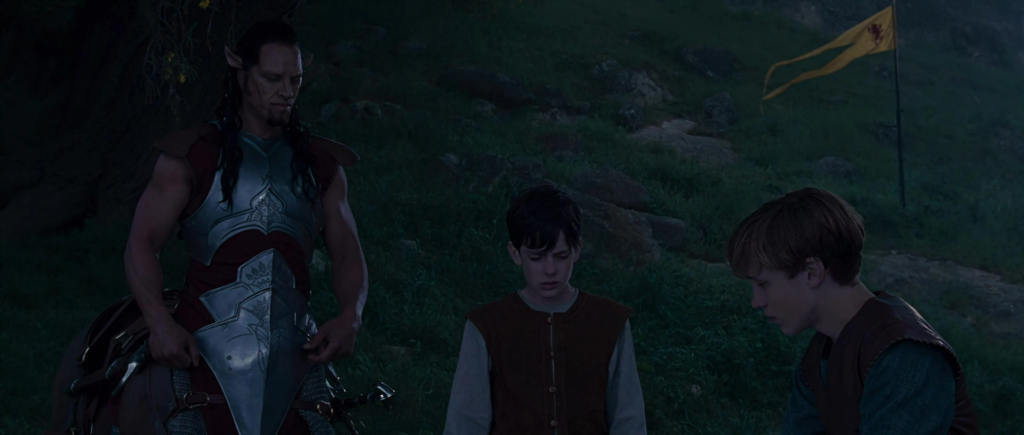
Still, I do appreciate how this scene demonstrates Edmund’s character development.
Edmund: Then you’ll have to lead us. (Beat) Peter, there’s an army out there and it’s ready to follow you.
Peter: I can’t!
Edmund: Aslan believed you could. So do I.
After being so resentful of Peter asserting any authority over him[8]Or Susan doing so for that matter., it’s really impressive to hear Edmund be the one to encourage him to take charge. I just wish Skandar Keynes, whose performance is generally stellar throughout the film, could have also conveyed that Edmund was experiencing horrific feelings of guilt during this moment. “The Witch’s army is nearing, Sire,” Oreius tells Peter. “What are your orders?”
Next Week: ….
References
| ↑1 | No pun intended. That’ll make sense in a little bit. |
|---|---|
| ↑2 | I’m not going to list all the species. If you’re interested, read the book or maybe look up some old promotional material for the movie. |
| ↑3 | I don’t necessarily mean that as a knock on those movies. After all, they were trying to tell a very different story from The Lion, the Witch and the Wardrobe with a different atmosphere and to a different audience. But if you ask at which evil army, I enjoy looking more, it’s the Narnian one. |
| ↑4 | Don’t tell me there’s no way she could do so! This is a great scene. |
| ↑5 | Remember that this adaptation’s version of Father Christmas specifically told her to trust in her bow. That wording might have significance. |
| ↑6 | The book also arguably had Susan show some impressive growth a little before this scene. Previously, she’d been the most fearful of the Pevensies, but she asked to accompany Aslan wherever he was going, no matter how bad it might be. |
| ↑7 | Browne is actually credited as a Green Dryad, not a cherry blossom one but since this is the only dryad with a speaking role in the movie, I assume it’s she. |
| ↑8 | Or Susan doing so for that matter. |
